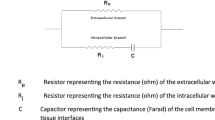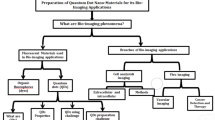Abstract
The mass energy absorption coefficient (\(\mu _{\mathrm{en}}/\rho\)), effective atomic number (\(Z_{\mathrm{PEA}_{\mathrm{eff}}}\)), and electron density (\(N_{\mathrm{PEA}_{\mathrm{eff}}}\)) of some biomolecules with potential application in radiation dosimetry were calculated for their photon energy absorption (PEA) in the energy region of 1–20 MeV. It was noticed that the values of \(\mu _{\mathrm{en}}/\rho\), \(Z_{\mathrm{PEA}_{\mathrm{eff}}}\), and \(N_{\mathrm{PEA}_{\mathrm{eff}}}\) vary with the energy and composition of the biomolecules. The results for \(Z_{\mathrm{PEA}_{\mathrm{eff}}}\) were compared with effective atomic numbers (\(Z_{\mathrm{PI}_{\mathrm{eff}}}\)) owing to the photon interaction (PI). Significant differences were noted between \(Z_{\mathrm{PEA}_{\mathrm{eff}}}\) and \(Z_{\mathrm{PI}_{\mathrm{eff}}}\) in the energy region of 10–150 keV for all of the biomolecules involved. A maximum difference of 45.36% was observed at 50 keV for creatinine hydrochloride. Moreover, the studied attenuation parameters were found to be sharply affected at the K-absorption edge of relatively high-Z elements present in the biomolecules.







Similar content being viewed by others
References
G.J. Hine, The effective atomic numbers of materials for various gamma ray interactions. Phys. Rev. 85, 725–737 (1952)
J.H. Hubbell, Photon mass attenuation and energy-absorption coefficients. Int. J. Appl. Radiat. Isot. 33(11), 1269–1290 (1982). https://doi.org/10.1016/0020-708X(82)90248-4
J.S. Revathy, J. Anooja, R.B. Krishnaveni et al., Effective atomic numbers in some food materials and medicines for \(\gamma\)-ray attenuation using \(^{137}\text{ Cs } \gamma\)-ray. Pramana-J. Phys. 90, 72 (2018). https://doi.org/10.1007/s12043-018-1570-9
R.S. Niranjan, B. Rudraswamy, N. Dhananjaya, Effective atomic number, electron density and kerma of gamma radiation for oxides of lanthanides. Pramana-J. Phys. 78, 451–458 (2012). https://doi.org/10.1007/s12043-011-0247-4
O. Eyecioglu, A.M. El-Khayatt, Y. Karabul et al., A study on compatibility of experimental effective atomic numbers with those predicted by ZXCOM. Nucl. Sci. Tech. 28, 63 (2017). https://doi.org/10.1007/s41365-017-0220-0
S.R. Manohara, S.M. Hanagodimath, K.S. Thind et al., The effective atomic number revisited in the light of modern photon-interaction cross-section databases. Appl. Radiat. Isot. 68(4–5), 784–787 (2010). https://doi.org/10.1016/j.apradiso.2009.09.047
G.J. Hine, G.L. Brownell, Radiation Dosimetry (Academic Prss Inc, New York, 1956). https://doi.org/10.1016/B978-1-4832-3257-7.50001-9
B.M. Ladhaf, P.P. Pawar, Studies on mass energy-absorption coefficients and effective atomic energy-absorption cross sections for carbohydrates. Radiat. Phys. Chem. 109, 89–94 (2015). https://doi.org/10.1016/j.radphyschem.2014.12.015
J.H. Hubbell, S.M. Seltzer, Tables of X-Ray mass attenuation coefficients and mass energy-absorption coefficients 1 keV to 20 MeV for Elements \(\text{ Z }=1\) to 92 and 48 Additional substances of Dosimetric Interest. NIST Standard Reference Database 126, (1995). https://doi.org/10.18434/T4D01F
C.T. Chantler, Theoretical form factor, attenuation, and scattering tabulation for \(\text{ Z }=1\)–92 from \(\text{ E }=1\)–10 eV to \(\text{ E }=0.4\)–1.0 MeV. J. Phys. Chem. Ref. Data 24(1), 71–643 (1995). https://doi.org/10.1063/1.555974
M.J. Berger, J.H. Hubbell, S.M. Seltzer et al., XCOM: photon cross sections database. NIST Standard Reference Database 8, (1998). https://doi.org/10.18434/T48G6X
L. Gerward, N. Guilbert, K.B. Jensen et al., WinXCom—a program for calculating X-ray attenuation coefficients. Radiat. Phys. Chem. 71, 653–654 (2004). https://doi.org/10.1016/j.radphyschem.2004.04.040
C.T. Chantler et al., X-ray form factor, attenuation and scattering tables, NIST Standard Reference. Database 66, (2005). https://doi.org/10.18434/T4HS32
S. Gowda, S. Krishnaveni, R. Gowda, Studies on effective atomic numbers and electron densities in amino acids and sugars in the energy range 30–1333 keV. Nucl. Instr. Meth. Phys. Res. B. 239, 361–369 (2005). https://doi.org/10.1016/j.nimb.2005.05.048
D.F. Jackson, H.J. David, X-ray attenuation coefficients of elements and mixtures. Phys. Rep. 70, 169–233 (1981). https://doi.org/10.1016/0370-1573(81)90014-4
G.K. Sandhu, K. Singh, B.S. Lark et al., Molar extinction coefficients of some fatty acids. Radiat. Phys. Chem. 65, 211–2015 (2002). https://doi.org/10.1016/S0969-806X(02)00269-4
A. Kumar, Studies on effective atomic numbers and electron densities of nucleobases in DNA. Radiat. Phys. Chem. 127, 48–55 (2016). https://doi.org/10.1016/j.radphyschem.2016.06.006
V.V. Awasarmol, D.K. Gaikwad, S.D. Raut et al., Photon interaction study of organic nonlinear optical materials in the energy range 122–1330 keV. Radiat. Phys. Chem. 130, 343–350 (2017). https://doi.org/10.1016/j.radphyschem.2016.09.012
Y. Elmahroug, B. Tellili, C. Souga et al., Determination of total mass attenuation coefficients, effective atomic numbers and electron densities for different shielding materials. Ann. Nucl. Energy 75, 268–274 (2015). https://doi.org/10.1016/j.anucene.2014.08.015
B.O. Elbashir, M.G. Dong, M.I. Sayyed et al., Comparison of Monte Carlo simulation of gamma ray attenuation coefficients of amino acids with XCOM program and experimental data. Results Phys. 9, 6–11 (2018). https://doi.org/10.1016/j.rinp.2018.01.075
B. Akça, S.Z. Erzeneoğlu, The mass attenuation coefficients, electronic, atomic, and molecular cross sections, effective atomic numbers, and electron densities for compounds of some biomedically important elements at 59.5 keV. Sci. Technol. Nucl. Ins. (2014). https://doi.org/10.1155/2014/901465
B.S. Sidhu, A.S. Dhaliwal, K.S. Mann et al., Study of mass attenuation coefficients, effective atomic numbers and electron densities for some low Z compounds of dosimetry interest at 59.54 keV incident photon energy. Ann. Nucl. Energy 42, 153–157 (2012). https://doi.org/10.1016/j.anucene.2011.12.015
N.A.B. Amin, J. Zukhi, N.A. Kabir et al., Determination of effective atomic numbers from mass attenuation coefficients of tissue-equivalent materials in the energy range 60 keV–1.33 MeV. J. Phys. Conf. Ser. 851, 012018 (2017). https://doi.org/10.1088/1742-6596/851/1/012018
H.C. Manjunatha, B. Rudraswamy, Study of effective atomic number and electron density for tissues from human organs in the energy range of 1 keV–100 GeV. Health Phys. 104(2), 158–162 (2013). https://doi.org/10.1097/HP.0b013e31827132e3
V.P. Singh, N.M. Badiger, N. Kucuk, Assessment of methods for estimation of effective atomic numbers of common human organ and tissue substitutes: waxes, plastics and polymers. Radioprotection 49(2), 115–121 (2014). https://doi.org/10.1051/radiopro/2013090
M. Kurudirek, T. Onaran, Calculation of effective atomic number and electron density of essential biomolecules for electron, proton, alpha particle and multi-energetic photon interactions. Radiat. Phys. Chem. 112, 125–138 (2015). https://doi.org/10.1016/j.radphyschem.2015.03.034
D. Salehi, D. Sardari, M.S. Jozani, Investigation of some radiation shielding parameters in soft tissue. J. Radiat. Res. Appl. Sci. 8(3), 439–445 (2015). https://doi.org/10.1016/j.jrras.2015.03.004
S.R. Manohara, S.M. Hanagodimath, L. Gerward, Studies on effective atomic number, electron density and kerma for some fatty acids and carbohydrates. Phys. Med. Biol. 53(20), N377–86 (2008). https://doi.org/10.1088/0031-9155/53/20/N01
H. Arslan, Photon attenuation parameters for some tissues from Geant4 simulation, theoretical calculations and experimental data: a comparative study. Nucl. Sci. Tech. 30, 96 (2019). https://doi.org/10.1007/s41365-019-0617-z
J.H. Hubbell, Photon Mass Attenuation and Mass Energy-Absorption Coefficients for H, C, N, O, Ar, and Seven Mixtures from 0.1 keV to 20 MeV. Radiat. Res. 70, 58–81 (1977). https://doi.org/10.2307/3574732
S.R. Manohara, S.M. Hanagodimath, Effective atomic numbers for photon energy absorption of essential amino acids in the energy range 1 keV to 20 MeV. Nucl. Instr. Meth. Phys. Res. B 264, 9–14 (2007). https://doi.org/10.1016/j.nimb.2007.08.018
A. Shantappa, S.G. Gounhalli, S.M. Hanagodimath, Energy dependence of effective atomic numbers for photon energy absorption of vitamins. IOSR J. Appl. Phys. 2, 49–56 (2012)
V.P. Singh, M.E. Medhat, N.M. Badiger, Photon energy absorption coefficients for nuclear track detectors using Geant4 Monte Carlo simulation. Radiat. Phys. Chem. 106, 83–87 (2015). https://doi.org/10.1016/j.radphyschem.2014.07.001
M. Singh, A. Tondon, B.S. Sandhu et al., Energy dependence of radiation interaction parameters of some organic compounds. Radiat. Phys. Chem. 145, 80–88 (2018). https://doi.org/10.1016/j.radphyschem.2017.12.020
P.P. Pawar, G.K. Bichile, Studies on mass attenuation coefficient, effective atomic number and electron density of some amino acids in the energy range 0.122–1.330 MeV. Radiat. Phys. Chem. 92, 22–27 (2013). https://doi.org/10.1016/j.radphyschem.2013.07.004
P.S. Kore, P.P. Pawar, Measurements of mass attenuation coefficient, effective atomic number and electron density of some amino acids. Radiat. Phys. Chem. 98, 86–91 (2014). https://doi.org/10.1016/j.radphyschem.2013.12.038
D.K. Gaikwad, P.P. Pawar, T.P. Selvam, Mass attenuation coefficients and effective atomic numbers of biological compounds for gamma ray interactions. Radiat. Phys. Chem. 138, 75–80 (2017). https://doi.org/10.1016/j.radphyschem.2017.03.040
B.T. Tonguc, H. Arslan, M.S. Al-Buriahi, Studies on mass attenuation coefficients, effective atomic numbers and electron densities for some biomolecules. Radiat. Phys. Chem. 153, 86–91 (2018). https://doi.org/10.1016/j.radphyschem.2018.08.025
M. Kurudirek, Y. Ozdemir, A comprehensive study on energy absorption and exposure buildup factors for some essential amino acids, fatty acids and carbohydrates in the energy range 0.015–15 MeV up to 40 mean free path. Nucl. Instr. Methods Phys. Res. B. 269, 7–19 (2011). https://doi.org/10.1016/j.nimb.2010.10.015
S.R. Manohara, S.M. Hanagodimath, L. Gerward, The effective atomic numbers of some biomolecules calculated by two methods: a comparative study. Med. Phys. 36, 137–141 (2009). https://doi.org/10.1118/1.3030952
M. Kurudirek, T. Sinan, Investigation of human teeth with respect to the photon interaction, energy absorption and buildup factor. Nucl. Instr. Methods Phys. Res. B. 269, 1071–1081 (2011). https://doi.org/10.1016/j.nimb.2011.03.004
S.R. Manohara, S.M. Hanagodimath, Studies on effective atomic numbers and electron densities of essential amino acids in the energy range 1 keV–100 GeV. Nucl. Instr. Methods Phys. Res. B. 258, 321–328 (2007). https://doi.org/10.1016/j.nimb.2007.02.101
J.H. Hubbell, Review of photon interaction cross section data in the medical and biological context. Phys. Med. Biol. 44(1), R1–22 (1999). https://doi.org/10.1088/0031-9155/44/1/001
C.T. Chantler, Detailed tabulation of atomic form factors, photoelectric absorption and scattering cross section, and mass attenuation coefficients in the vicinity of absorption edges in the soft X-ray (\(Z=30\)–36, \(Z=60\)–89, \(E=0.1\ \text{ keV }\)–10 keV), addressing convergence issues of earlier work. J. Phys. Chem. Ref. Data 29, 597–1048 (2000). https://doi.org/10.1063/1.1321055
S. Glasstone, A. Sesonske, Nuclear reactor engineering. Nucl. Sci. Eng. 81, 484–485 (1982)
Author information
Authors and Affiliations
Corresponding author
Rights and permissions
About this article
Cite this article
Al-Buriahi, M.S., Arslan, H. & Tonguc, B.T. Investigation of photon energy absorption properties for some biomolecules. NUCL SCI TECH 30, 103 (2019). https://doi.org/10.1007/s41365-019-0636-9
Received:
Revised:
Accepted:
Published:
DOI: https://doi.org/10.1007/s41365-019-0636-9




